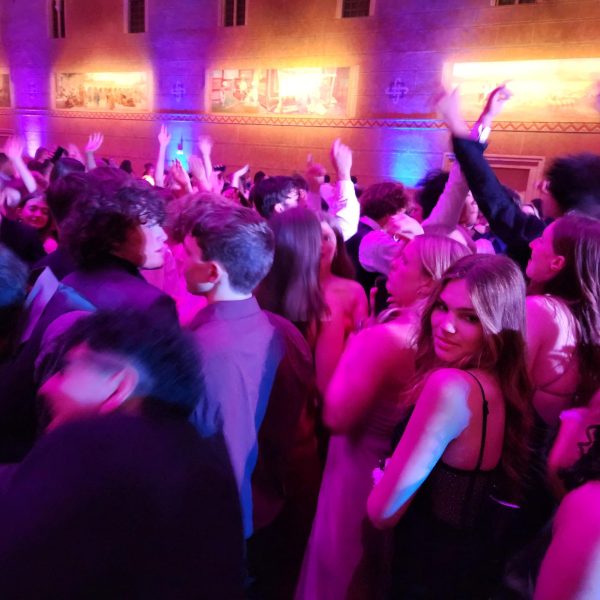How to connect a community

Leadership students talk with Bucky the Beaver at the 2019 Homecoming Assembly.
Assemblies are the only time all students and staff at BHS gather to embody a core value: Community Connects Us. BHS puts on three main types of assemblies: Celebration assemblies (introduced this year), leadership assemblies (typically for dances), and the Diversity Assembly from the Multicultural Student Union.
Unfortunately, not all assemblies hit the mark. How do we fix them?
Step 1: Figure out the volume issue.
We love the enthusiasm for music…except for when it’s on full blast. It’s too loud to focus, or even understand song lyrics. So, please, turn down the volume.
On the other hand, turn up the microphone volume when someone is speaking. Even in the front row of the sophomore section, it’s impossible to understand what’s being said, generating side conversations. We want to listen—we just can’t hear you.
Step 2: Make assemblies lively.
Nothing is less entertaining than watching a speaker recite a speech in a monotone voice on the gym floor. It’s understandable: speakers aren’t actors, and they’re nervous. But if it sounds like the speaker doesn’t care, why should the audience?
Have speakers rehearse multiple times: the best are those who sound like they’ve practiced. It sends a message to the audience: “We care, so you should, too.”
Step 3: Keep assemblies interactive.
Noteworthy assemblies are those where students participate or share their talents, such as the Homecoming assembly. But at celebration assemblies, the audience is talked at by robotic, incomprehensible student speakers—in short, they’re dull.
“There’s the leadership assemblies, which are really cool,” said junior Lucas Smith. “And then there are the recognition assemblies, which is: ‘Hey, look at some graphs, kids.’”
The community can’t connect because they can’t participate. So it’s exciting when the cheerleaders and Rhythm B’s show up: we see students doing what they love. Teachers showing off hidden talents? Even better. Each assembly should have a segment devoted to performances, not a slideshow spotlighting athletic events. Whether it be singing, dancing, acting, or even a magic trick, students want to connect.
“We need to focus less on sports and academics and more on arts and creativity, especially in the celebration assemblies,” said London Kirschner, a junior on the Rhythm B’s.
Sophomore Tierney Griffiths agrees. “If you want athletics, you can go to the games.”
Best of all are the assemblies where students are valued members of the audience. But those are in short supply.
“Right now, it’s a bunch of people sitting and listening and not doing anything,” junior Nick Ruscoe said. He suggested adding more interactive activities. These activities don’t have to be intricate: they can focus on physical challenges, school subjects, or BHS trivia. There could even be a friendly competition between grades during each month, with an announcement of the winner at each celebration assembly.
Step 4: Mix it up.
Celebration assemblies are predictable. Students file in with music blasting in the background, sit, listen to boring speeches, and rush out of the gym.
“They’re not as action-packed, they’re not as attention-grabbing, they’re bland,” said Ruscoe, comparing celebration assemblies to those put on by Leadership for dances. “They’re pretty much all the same.”
Give each assembly a unique twist. How about a guest speaker, or calling random members of the audience to the floor to compete for prizes? The prizes don’t have to be glamorous—a $5 gift card to Starbucks suffices. Heck, you could say the winner gets a free drink at the Pond and it’ll turn some heads.
This isn’t to say that assemblies shouldn’t be informative. But devoting a segment of each assembly to something special will bring the community together.
When in doubt, ask the student body. Send out a survey, or ask people in the halls what they want to see. Even if things don’t go as planned, we’ll appreciate the effort.
Building a community isn’t easy, and neither is putting on an assembly. But we value our community, and it’s time we connect to it. The first step? Improving our assemblies.

Melody is a senior at Beaverton High School who edits and writes opinion pieces about the school. She also enjoys both watching and performing in theater...

![District changes have led to restrictions on AP classes for underclassmen [Graphic made with Canva].](https://beavertonhummer.com/wp-content/uploads/2024/06/Comic-Bonanza-600x600.png)



